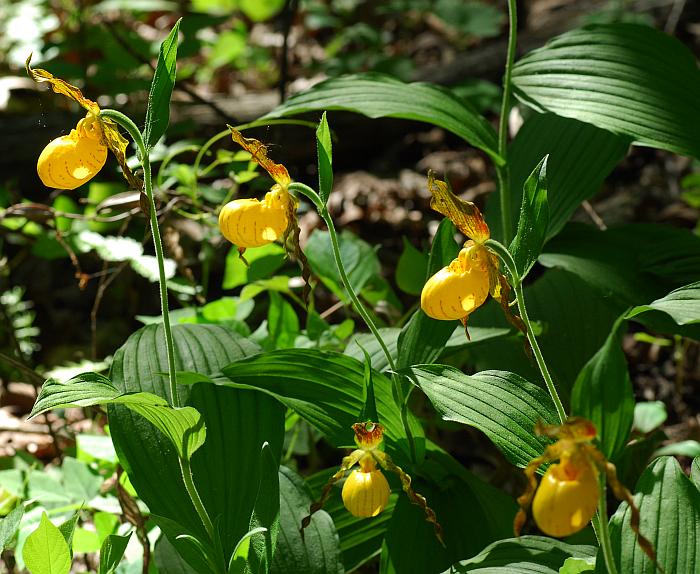Cypripedium parviflorum Salisb.
Yellow Lady's Slipper Orchid

Native
CC = 8
CW = Amb
MOC = 41
© SRTurner
Cypripedium parviflorum Salisb.Yellow Lady's Slipper Orchid | |
 |
Native CC = 8 CW = Amb MOC = 41 |
© SRTurner |
|
Family - Orchidaceae Habit - Rhizomatous perennial forb, often colonial. Stems - Ascending to erect, to 80 cm, usually densely hairy. Leaves - Alternate, simple, entire, sessile, 3-6 per flowering stem, 14-20 cm long, more than 4 cm wide, ovate to elliptic, somewhat ribbed or corrugated, hairy.
Inflorescence - One or two terminal flowers, each subtended by a leafy bract.
Flowers - Sepals 2-5 cm long, ovate-lanceolate, undulate or somewhat spirally twisted, yellowish green or reddish purple to brown. Lateral petals spreading, in some species somewhat downward arching or drooping, 3-9 cm long, longer than the lip, linear-lanceolate, spirally twisted, yellowish green or reddish purple to brown. Lip 2-5 cm long, obovoid, the margins rolled inward along the edge of the opening, yellow (rarely white), usually with red spots on the inside surface and around the opening. Column 15-25 mm long, the staminode triangular, yellow with red spots. Lateral petals . Lip enlarged to form a slipperlike pouch. Column with 2 stamens on either side near the tip, the tip with a large, ovate to triangular staminode.
Flowering - April - June. Habitat - North and East-facing slopes of ravines, mesic, upland woods. Origin - Native to U.S., Europe, and Asia. Other info. - This showy and striking species can be found throughout Missouri. The plant is just one of a larger complex of plants which occur in Europe, Asia, and North America. At present, two varieties are recognized in Missouri. Variety parviflorum has a corolla lip 2-3 cm long, and 4-6 leaves per flowering stem. Variety pubescens (Willd.) O.W. Knight has a corolla lip 3-6 cm long and 3-4 leaves per flowering stem. Both varieties are commonly scattered throughout the state, and the set of images above may include both varieties. A rare white form of var. parviflorum has been collected in Missouri in a couple of southern counties. The species was long known as C. calceolus, with this epithet also applied to the varieties. Photographs taken in Linville, NC., 4-30-03 (DETenaglia); also at Daniel Boone Conservation Area, Warren County, MO, 5-17-2008, and St. Joe State Park, St. Francois County, MO, 5-13-2015 and 5-15-2017 (SRTurner). |